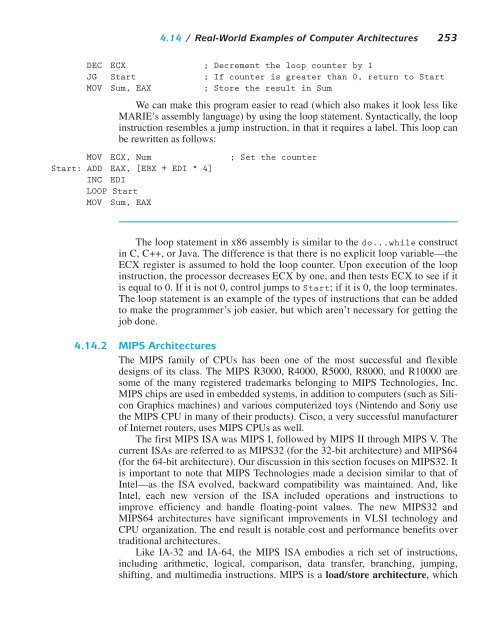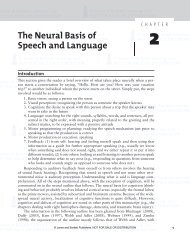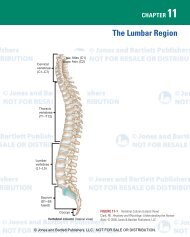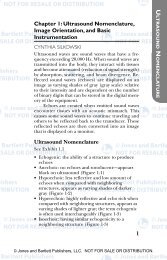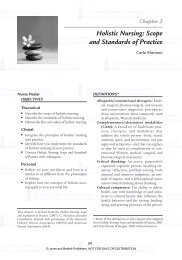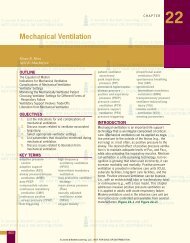An Introduction to a Simple Computer - Jones & Bartlett Learning
An Introduction to a Simple Computer - Jones & Bartlett Learning
An Introduction to a Simple Computer - Jones & Bartlett Learning
Create successful ePaper yourself
Turn your PDF publications into a flip-book with our unique Google optimized e-Paper software.
00068_CH04_Null.qxd 10/18/10 12:03 PM Page 253<br />
4.14 / Real-World Examples of <strong>Computer</strong> Architectures 253<br />
DEC ECX ; Decrement the loop counter by 1<br />
JG Start ; If counter is greater than 0, return <strong>to</strong> Start<br />
MOV Sum, EAX ; S<strong>to</strong>re the result in Sum<br />
We can make this program easier <strong>to</strong> read (which also makes it look less like<br />
MARIE’s assembly language) by using the loop statement. Syntactically, the loop<br />
instruction resembles a jump instruction, in that it requires a label. This loop can<br />
be rewritten as follows:<br />
MOV ECX, Num; Set the counter<br />
Start: ADD EAX, [EBX + EDI * 4]<br />
INC EDI<br />
LOOP Start<br />
MOV Sum, EAX<br />
The loop statement in x86 assembly is similar <strong>to</strong> the do...while construct<br />
in C, C++, or Java. The difference is that there is no explicit loop variable—the<br />
ECX register is assumed <strong>to</strong> hold the loop counter. Upon execution of the loop<br />
instruction, the processor decreases ECX by one, and then tests ECX <strong>to</strong> see if it<br />
is equal <strong>to</strong> 0. If it is not 0, control jumps <strong>to</strong> Start; if it is 0, the loop terminates.<br />
The loop statement is an example of the types of instructions that can be added<br />
<strong>to</strong> make the programmer’s job easier, but which aren’t necessary for getting the<br />
job done.<br />
4.14.2 MIPS Architectures<br />
The MIPS family of CPUs has been one of the most successful and flexible<br />
designs of its class. The MIPS R3000, R4000, R5000, R8000, and R10000 are<br />
some of the many registered trademarks belonging <strong>to</strong> MIPS Technologies, Inc.<br />
MIPS chips are used in embedded systems, in addition <strong>to</strong> computers (such as Silicon<br />
Graphics machines) and various computerized <strong>to</strong>ys (Nintendo and Sony use<br />
the MIPS CPU in many of their products). Cisco, a very successful manufacturer<br />
of Internet routers, uses MIPS CPUs as well.<br />
The first MIPS ISA was MIPS I, followed by MIPS II through MIPS V. The<br />
current ISAs are referred <strong>to</strong> as MIPS32 (for the 32-bit architecture) and MIPS64<br />
(for the 64-bit architecture). Our discussion in this section focuses on MIPS32. It<br />
is important <strong>to</strong> note that MIPS Technologies made a decision similar <strong>to</strong> that of<br />
Intel—as the ISA evolved, backward compatibility was maintained. <strong>An</strong>d, like<br />
Intel, each new version of the ISA included operations and instructions <strong>to</strong><br />
improve efficiency and handle floating-point values. The new MIPS32 and<br />
MIPS64 architectures have significant improvements in VLSI technology and<br />
CPU organization. The end result is notable cost and performance benefits over<br />
traditional architectures.<br />
Like IA-32 and IA-64, the MIPS ISA embodies a rich set of instructions,<br />
including arithmetic, logical, comparison, data transfer, branching, jumping,<br />
shifting, and multimedia instructions. MIPS is a load/s<strong>to</strong>re architecture, which


